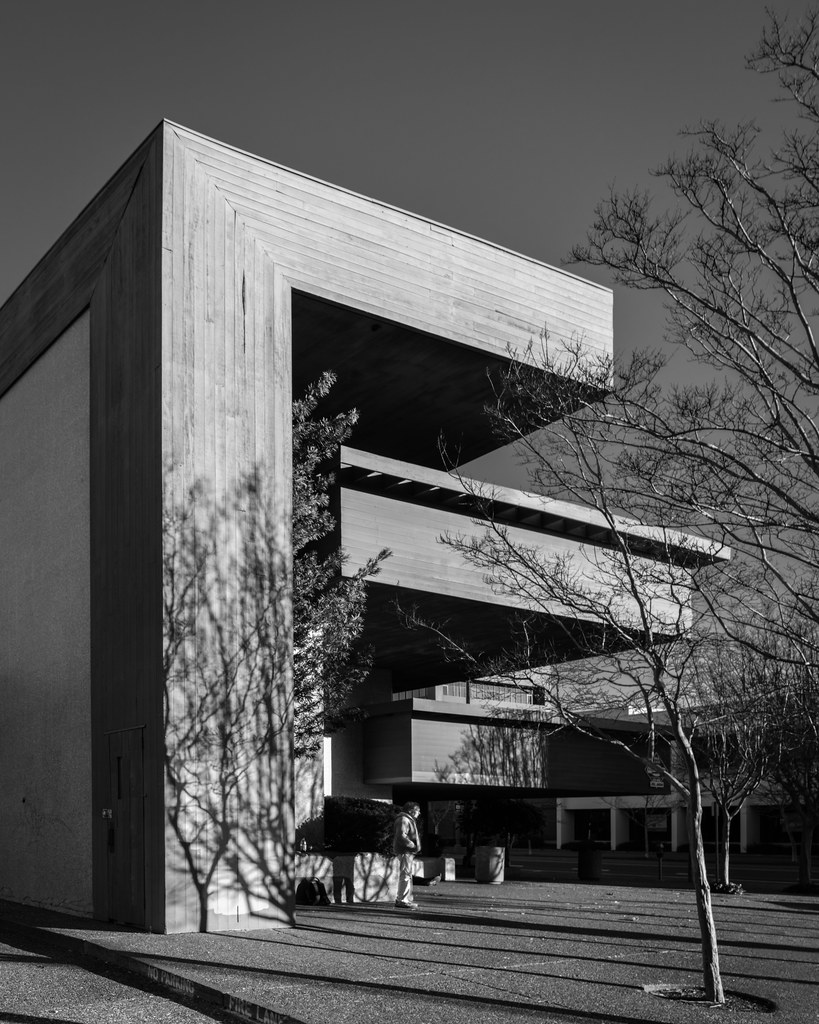 |
| An abandoned bank in downtown Santa Rosa. Photo ©Darren Bradley |
Mid-Century Modernist architecture is far from safe these days. But there’s a growing contingent supporting its preservation, and it’s now finally starting to at least be recognized - if not valued - by the public at large. The same cannot yet be said for its generally unloved - or at least under-appreciated - younger sibling, Late Modernism. Often confused with (*shudder*) Post-Modernist architecture, which admittedly overlaps it a bit, it’s nonetheless it’s own distinct genre, and one that is more firmly planted in the Modernist design philosophies that preceded it than in the post-Modernist follies that followed. And strange as it may seem, I’ve just discovered that one of the best places to experience this type of architecture is in Santa Rosa, in the heart of Sonoma County.
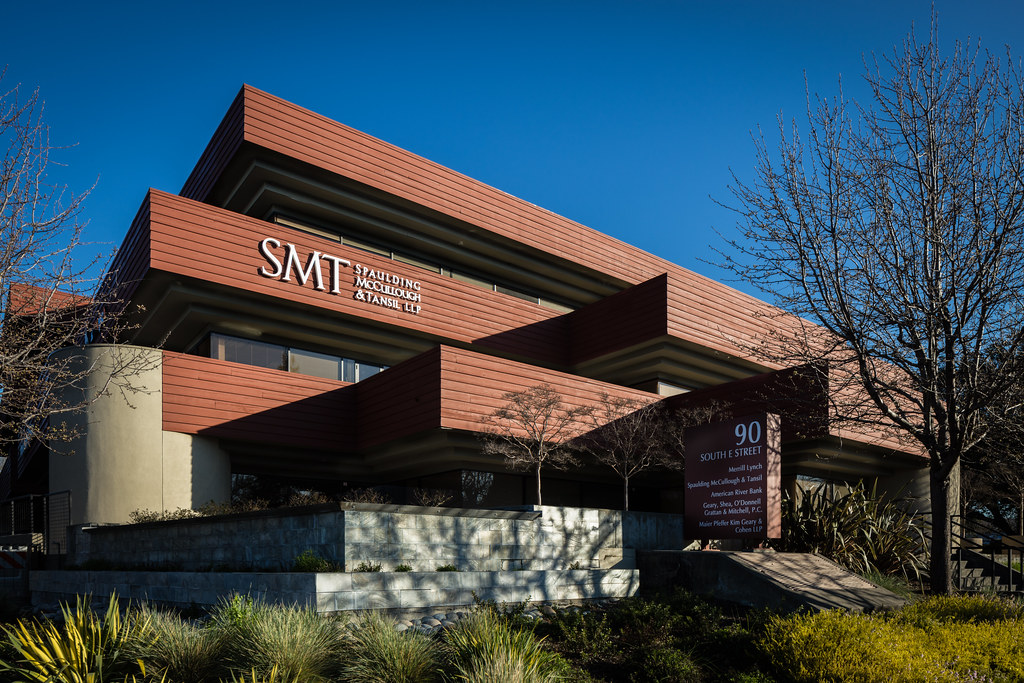 |
Late Modernists loved their chunky, cantilevered terraces. Photo ©Darren Bradley
One of the things that fascinates me most about architecture is how it reflects the general mood of society at the time. The post-World War II period was a time of re-invention and unbridled optimism about a Brave New World (spoken without irony). Totalitarianism had been defeated by freedom. Colonies were gaining their independence and becoming (hopefully) democratic countries. Science and technology were feeding the planet, ridding the humanity of disease, and opening up new frontiers in travel - even to outer space. The buildings of the 1950s and into the early 60s reflected that new paradigm. They were transparent and full of light, appearing to float effortlessly. Even banks, churches, corporate headquarters, and government buildings, which had traditionally been built as stone fortresses meant to convey their eternal strength and fortitude, became glass palaces. They evoked space ships and jets, and the !
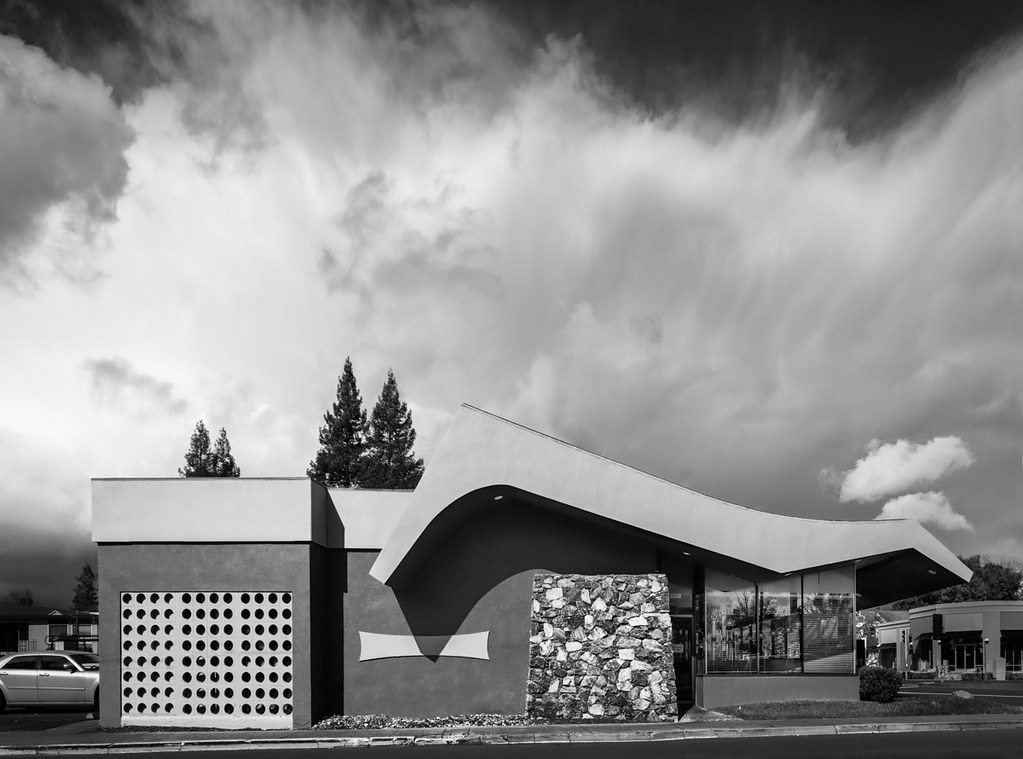
The former Sambo's restaurant in Santa Rosa embodies space-age Googie architecture that was so typical of diners in the 1950s and 60s. Photo ©Darren Bradley
|
But by the late 1960s and especially into the 1970s, the harsher realities of the Cold War, Vietnam, economic recessions, the nuclear arms race, energy crises and oil embargoes had taken their toll on society. That unbridled optimism had given way to worry, pessimism and negativity. Building codes and regulations also changed and become more onerous, with stricter mandates for seismic reinforcements, fire safety, and energy efficiency.
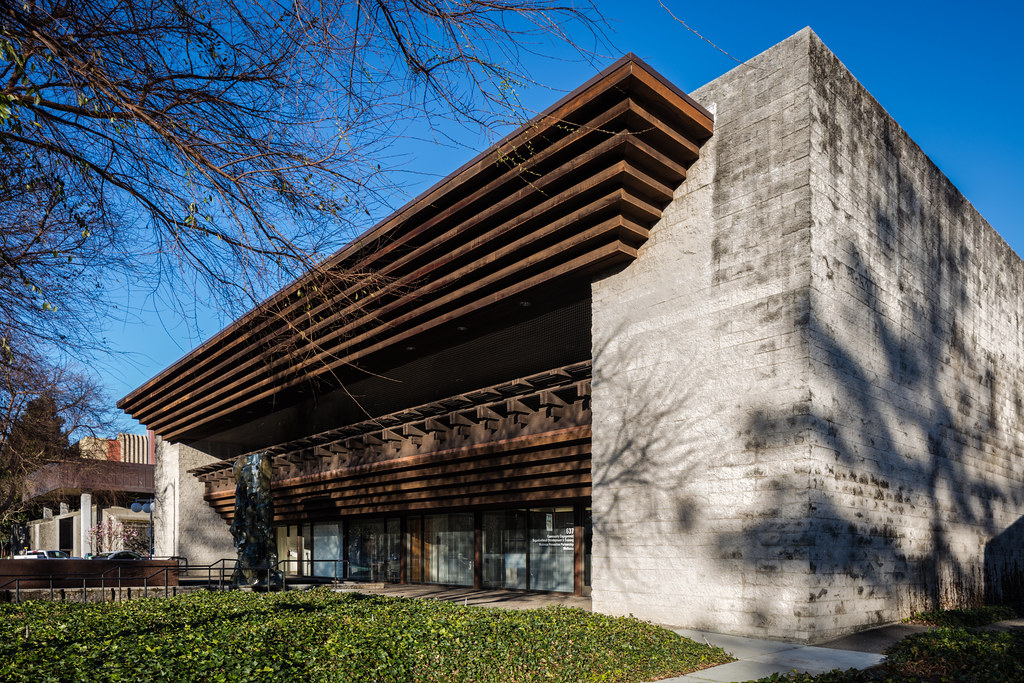 |
| Civic Plaza in Santa Rosa. Photo ©Darren Bradley |
Modernist architects did their best to adapt in the 1970s. They continued to eschew a lot of ornamentation, and maintained a sense of symmetry and repetitive patterns (albeit sometimes intentionally breaking that symmetry). But the glass curtain walls and thin, floating rooflines which had once been a defining feature of Modernist architecture gave way to thick, concrete walls.
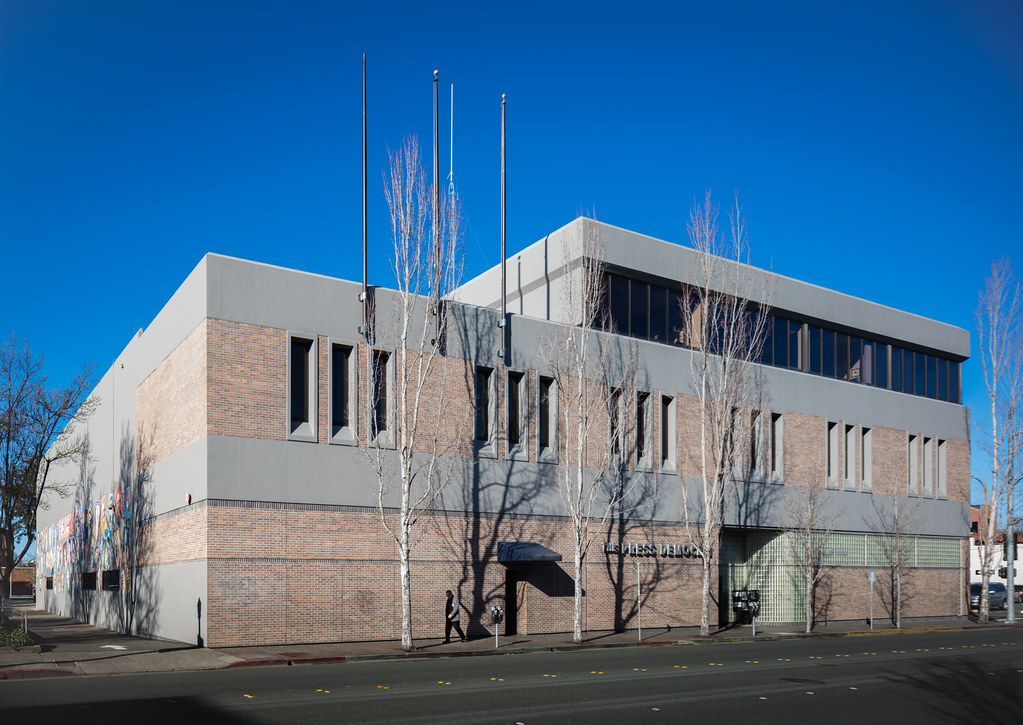 |
Even the local newspaper of record, the Press-Democrat, got into the act. Note the heavy reliance on brick and concrete, with small vertical windows throughout.
Photo ©Darren Bradley |
Unlike earlier examples of what we’d consider to be Brutalist architecture, where the concrete was left raw and exposed, Late Modernism often sought to present a more refined image. Concrete was polished, painted, hammered, or tiled. Rooflines and eaves became thick and heavy.
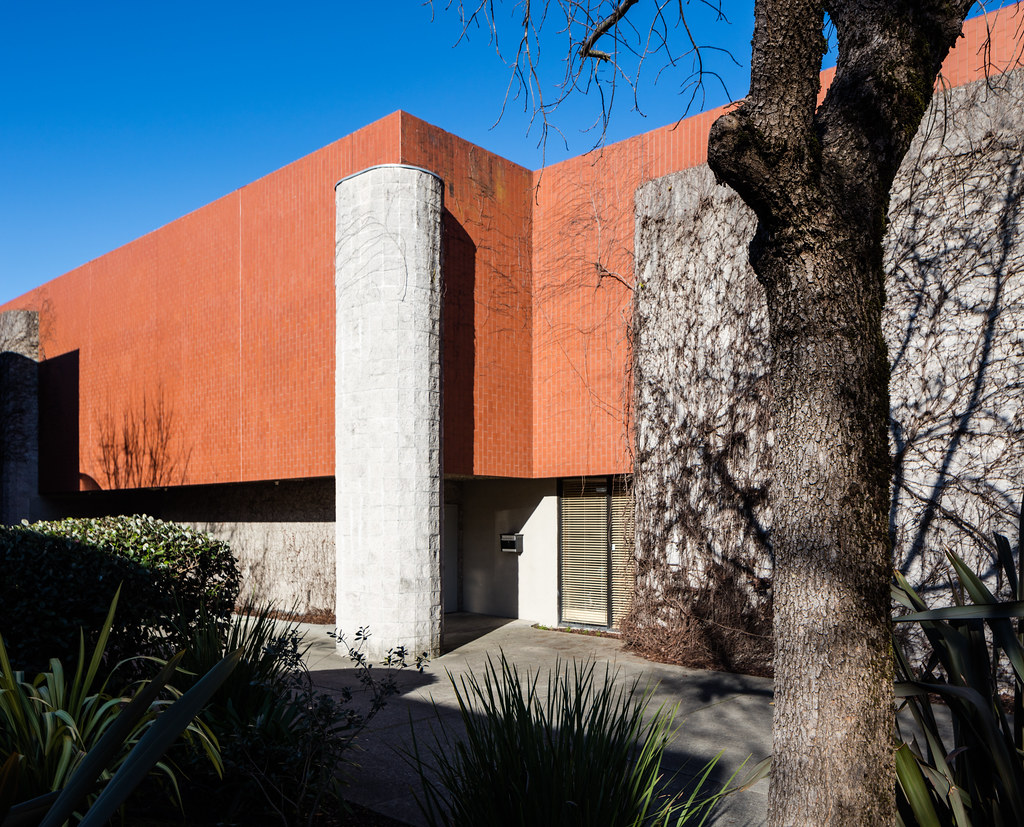 |
| A church in downtown Santa Rosa. Very thick rooflines made of concrete and concrete blocks, polished, tiled, or hammered to create some texture. The back alley of this church in Santa Rosa exemplifies all three. Photo ©Darren Bradley |
Those thin, light, post & beam, wood and glass pavilions of the 50s began to give way to heavy, almost bunker-like buildings with thick walls and few windows. The buildings, like the people, began to hunker down.
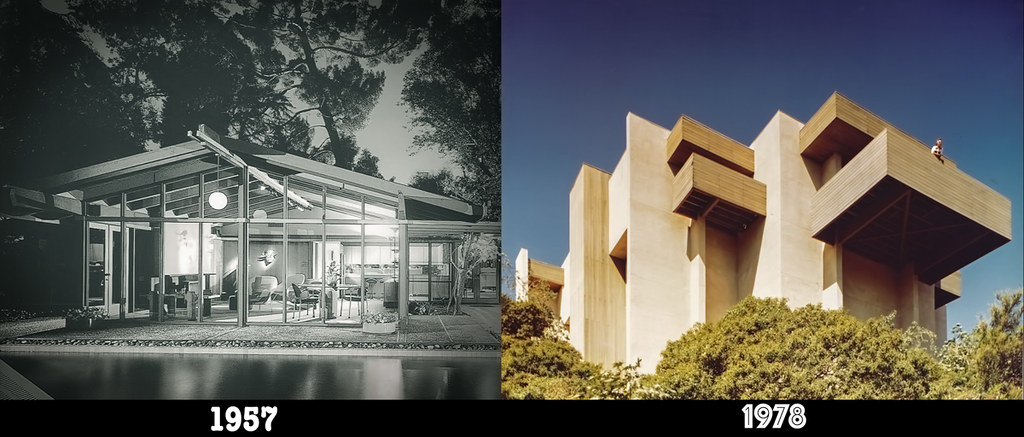 |
| Architects Buff & Hensman designed both of these homes. At left reflects the exuberance, light, and tranparency. At right is the bunker-like design of the same firm, reflecting the different moods at the time. |
With all that, it’s little wonder that Late Modernist architecture has been the unloved step-child of the architecture world. Very little has been written about it recently. Most writing about Late Modernism focuses on art and literature, rather than architecture, although I did find a nice article on the subject on Curbed, by Alexandra Lange. Fans of Modernism generally prefer the more pure forms of the earlier Mid-Century examples. Post-Modernists consider it to be a pale, weak pre-cursor to the decadent historical references and kitsch, brashness and sense of humor that embodies Post-Modernism.
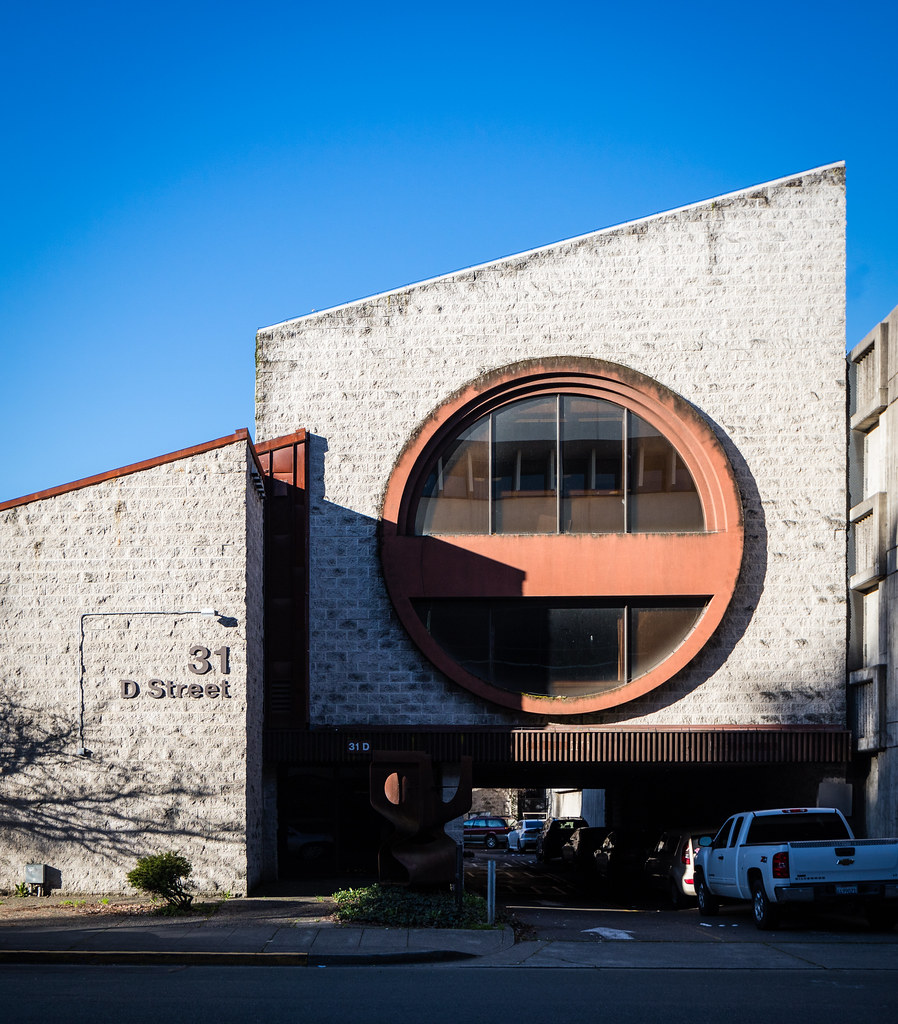 |
| Some people may consider this to be more Post-Modern than Late-Modern... Nah. Photo ©Darren Bradley |
And fans of more traditional, classic architecture - or just the average layman who generally doesn’t think about such things - is unlikely to appreciate the heavy use of concrete and other “cold” materials and non-traditional styles.
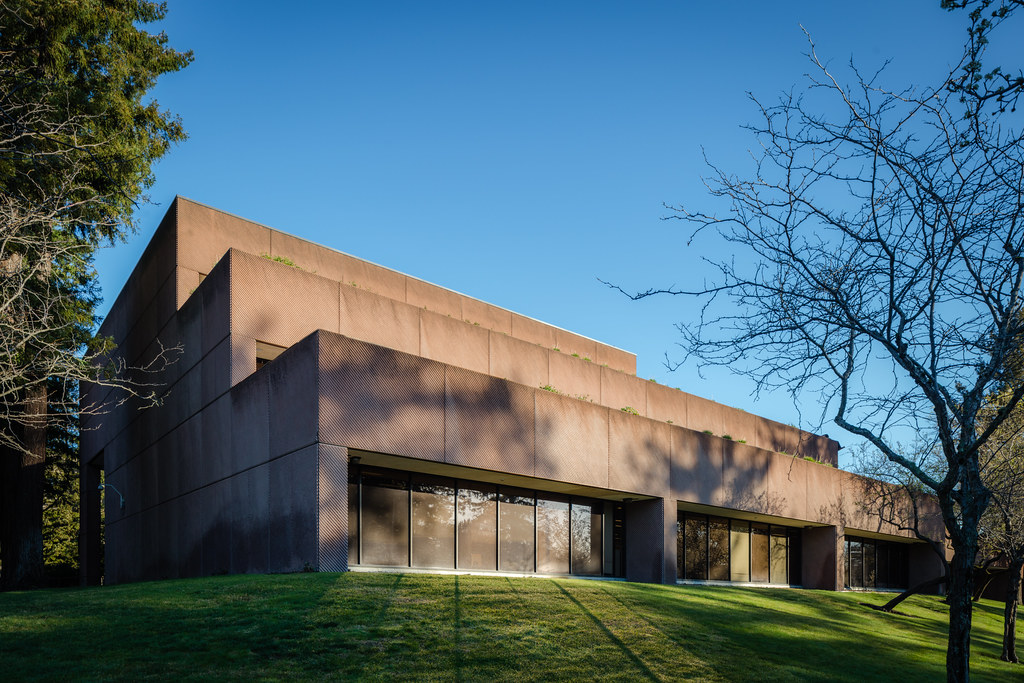 |
| The monolithic Federal Building in Santa Rosa. Photo ©Darren Bradley |
That’s not to say there isn’t still a lot to appreciate about Late Modernist architecture, however. Unable or unwilling to rely on the classic tropes of post & beam glass pavilions, architects of this time used new materials and forms to create bold structures and interesting patterns. They used the structural integrity that those heavy concrete walls provide to create cantilevered balconies galore, and lots of cavernous, open spaces free of supporting beams that would otherwise be required with flimsier materials.
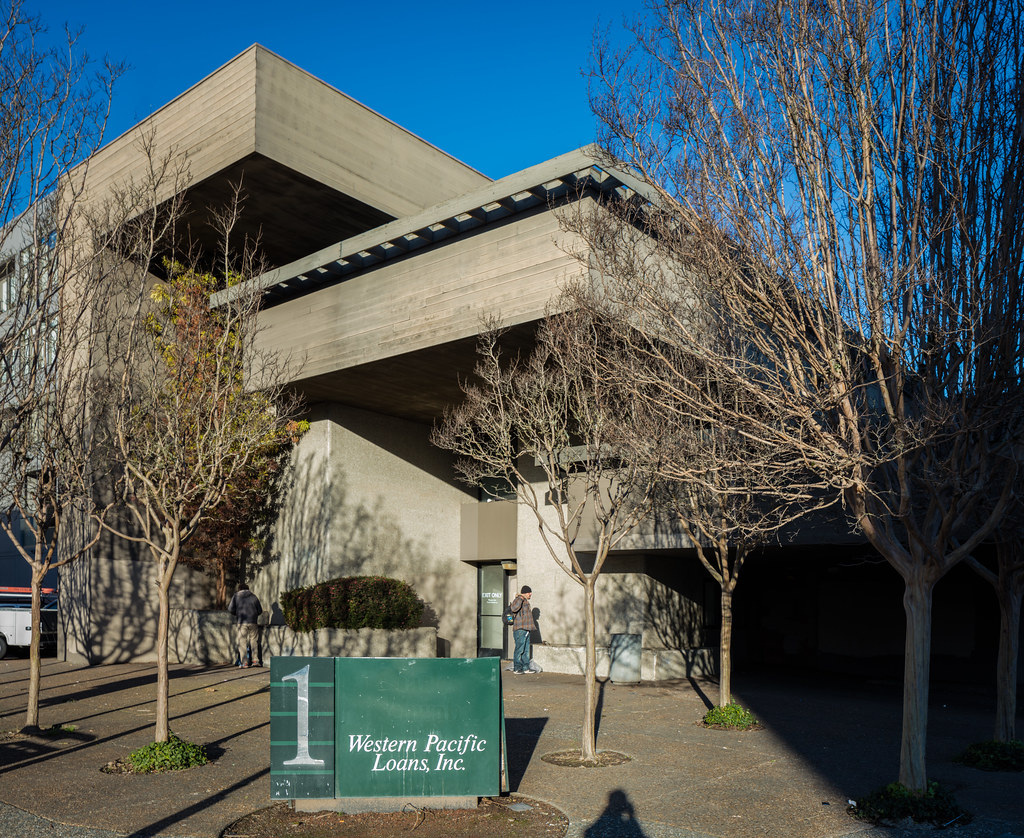 |
| The now empty Western Pacific Loans building in Santa Rosa. Photo ©Darren Bradley |
The results can be quite dramatic, and it’s little wonder that so many shopping centers, hotels, and corporate office buildings embraced this style throughout the 70s and into the 80s.
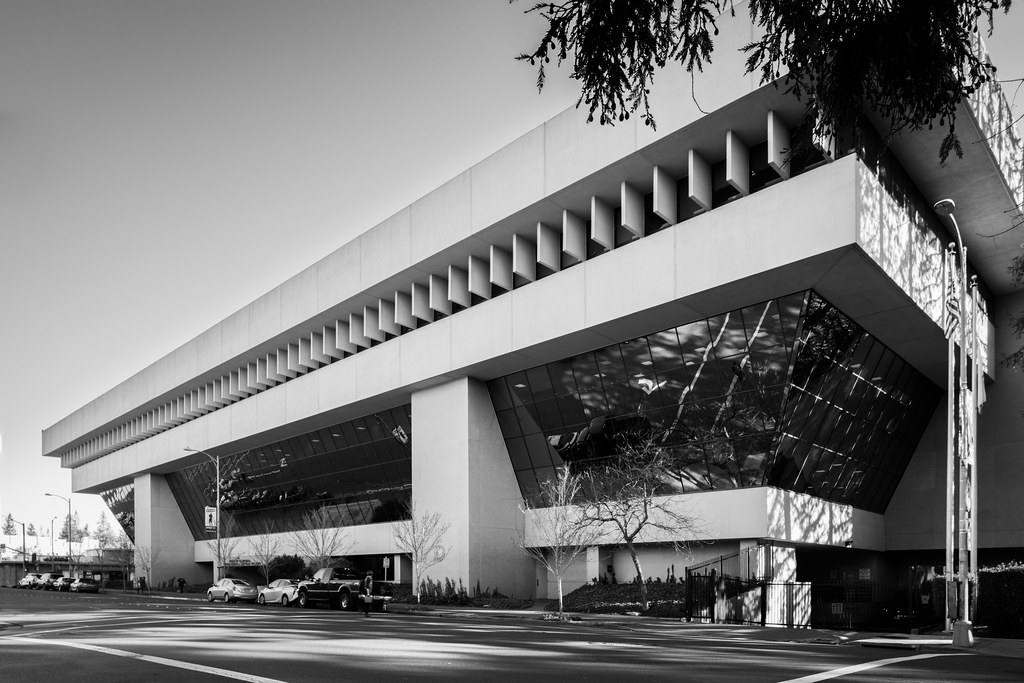 |
| Government building in Santa Rosa. Photo ©Darren Bradley |
So anyway, back to Santa Rosa. After passing through Santa Rosa last year a couple of times and photographing its wonderful Modernist library, I was invited by manager of the library’s history department to come up to speak about its design and the architect who designed it.
 |
| A more classic mid-century modern style for the Central Library in Santa Rosa, designed by Francis Joseph McCarthy. Photo ©Darren Bradley |
While here for my quick trip, I had a couple of hours free to wander and explore the downtown area. I found a few Mid-Century modern buildings I hadn’t yet photographed.
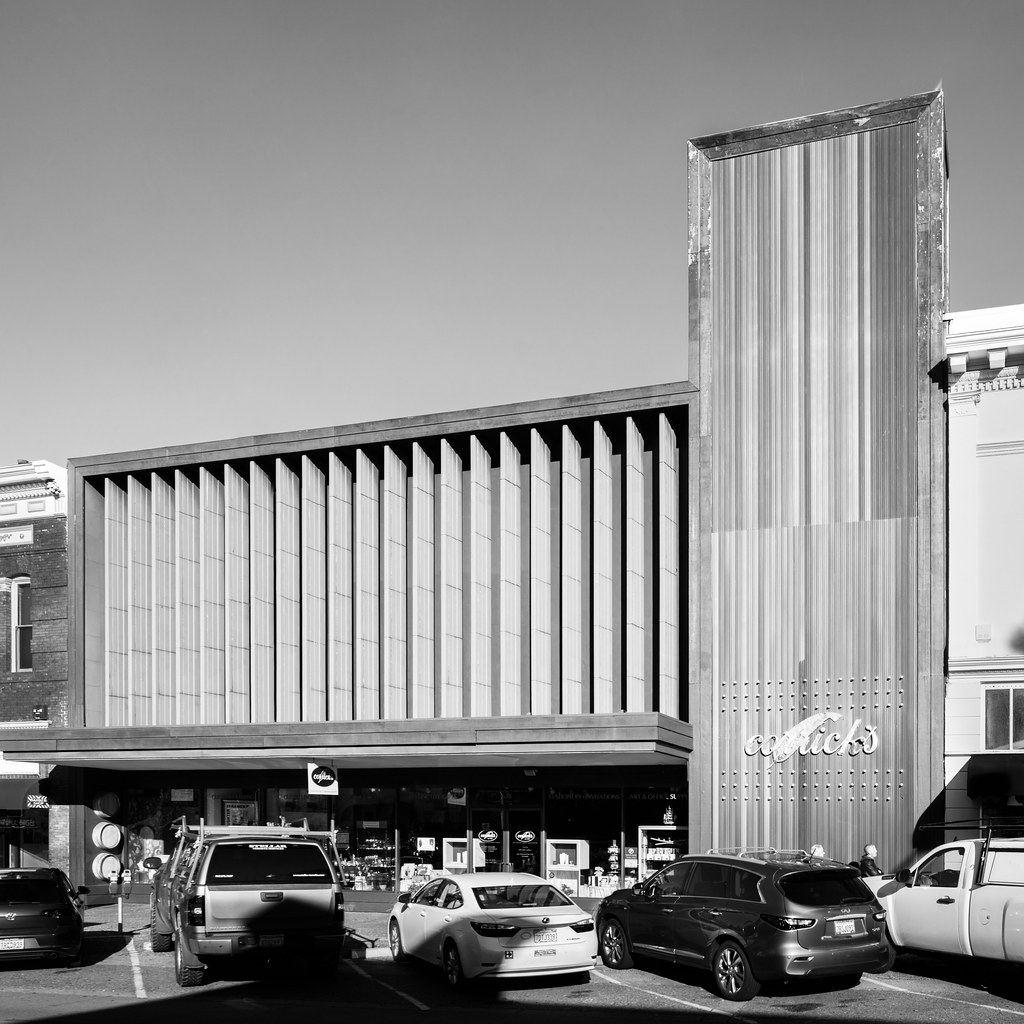 |
| Corrick's Stationery store in downtown Santa Rosa is a real treat, and a beautiful building. Photo ©Darren Bradley |
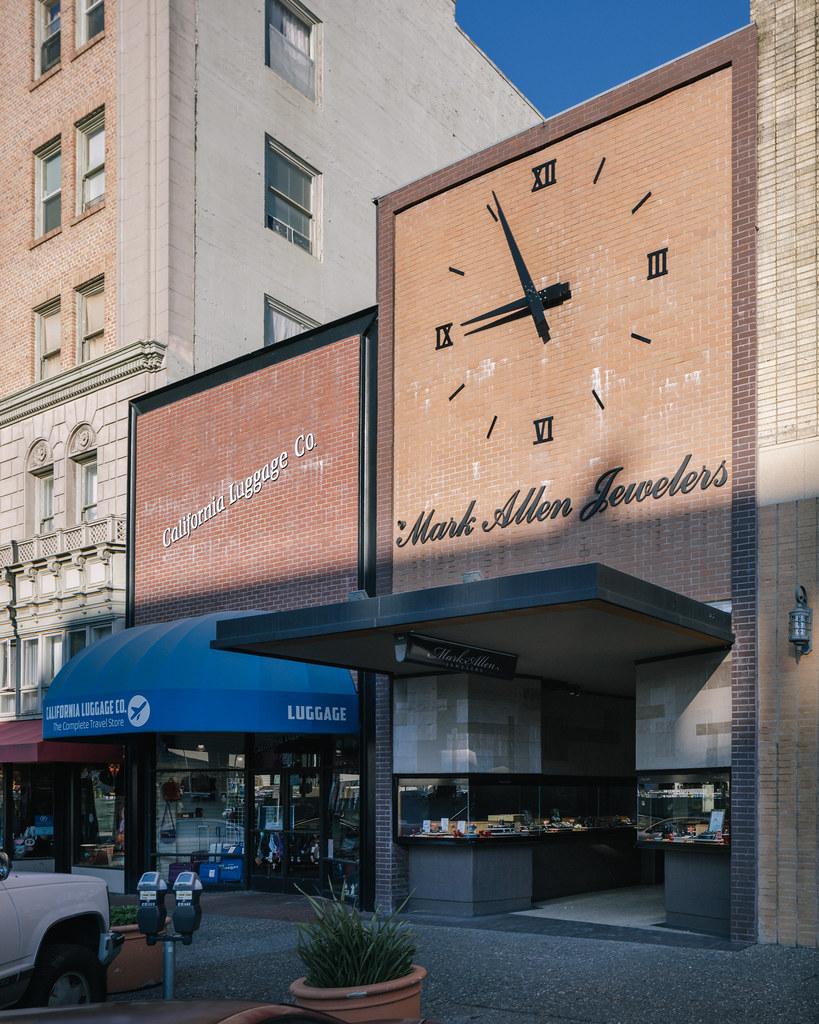 |
| Is the clock big enough? Photo ©Darren Bradley |
But what stood out most in my explorations was how many great examples of Late Modernist architecture there are in Santa Rosa.
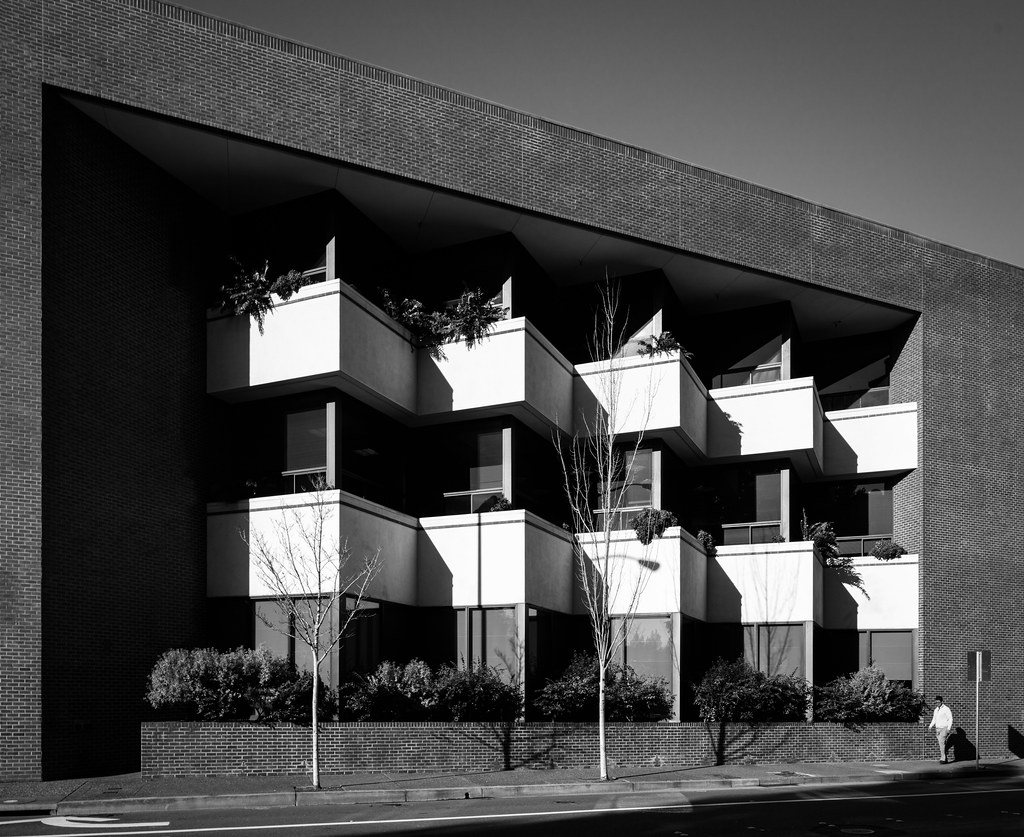 |
| Photo ©Darren Bradley |
In fact, most of the buildings in its downtown core are firmly Late Modern. Granted, Santa Rosa is a small city, so there aren’t a lot of gleaming corporate headquarters or large atrium hotels. But there are plenty of smaller-scale buildings of this genre which are quite interesting and even beautiful.
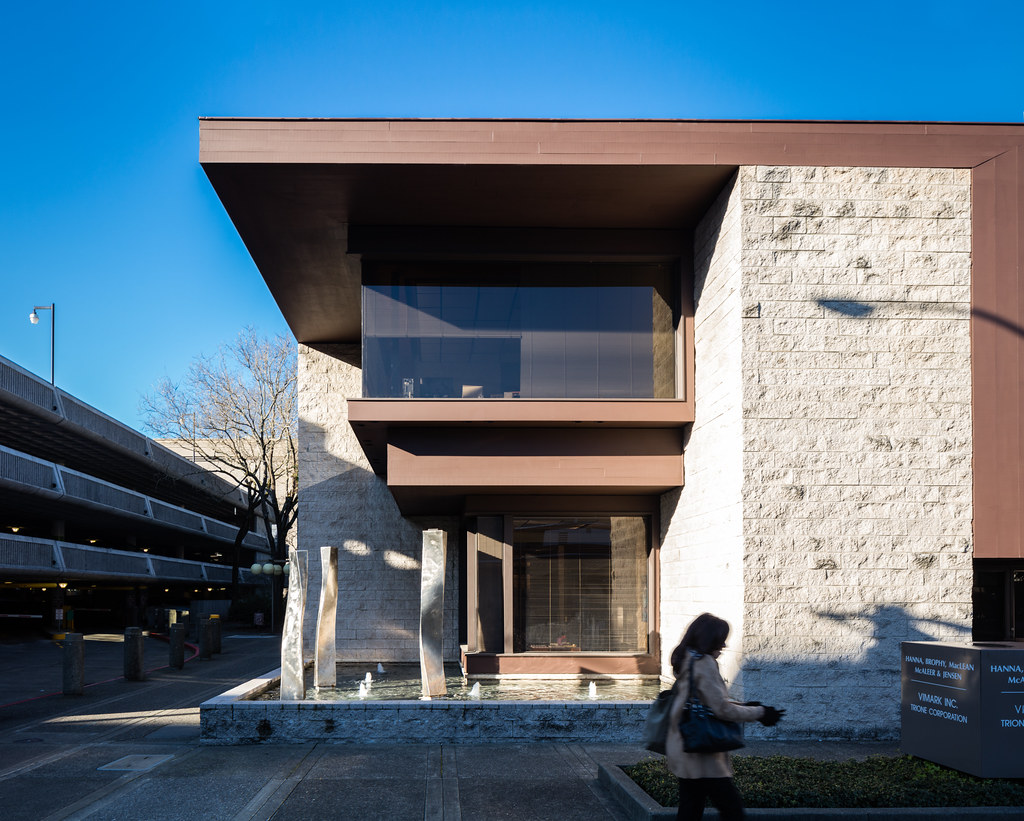 |
| Small legal office building in Santa Rosa. Photo ©Darren Bradley |
I thought that was curious, and as I walked around, I tried to figure out why that might be. Was there a big economic boom in the 1970s that spurred development in the region? Not that I could think of off hand…
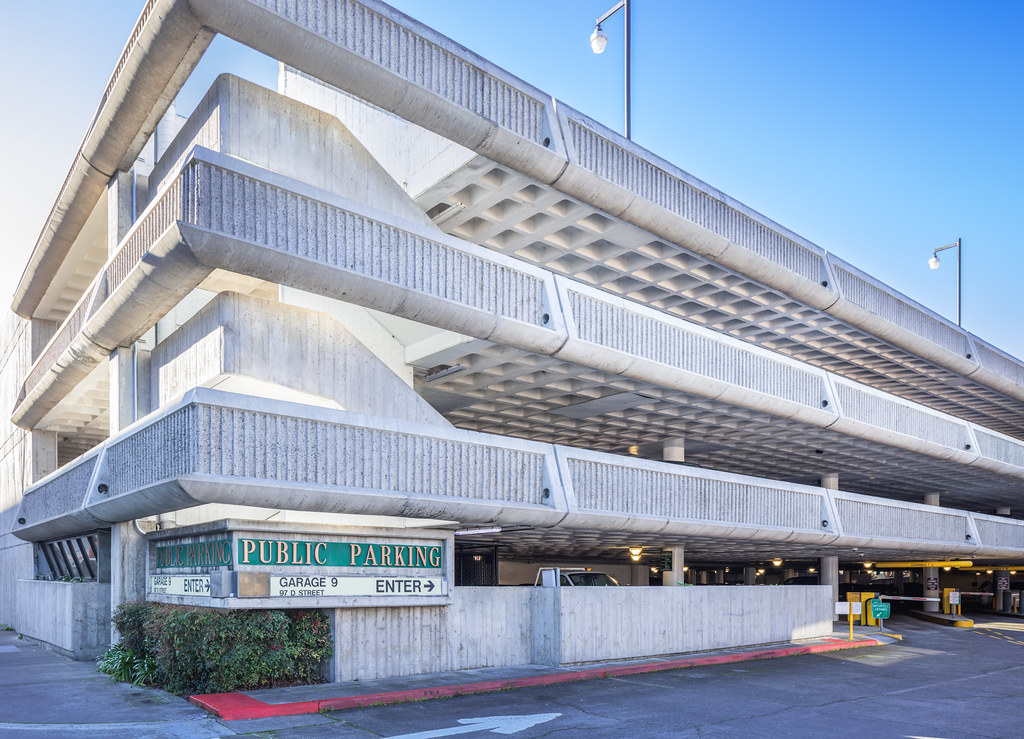 |
| Mmmmmm.... waffles. Photo ©Darren Bradley |
Had Sonoma been where all of the Modernist architects came to retire and retrench when Post-Modernism started taking over the big cities? Possibly but that couldn’t be it. It was curious, also, how relatively few Mid-Century Modern structures were in the city, compared to the large number of Late Modern buildings.
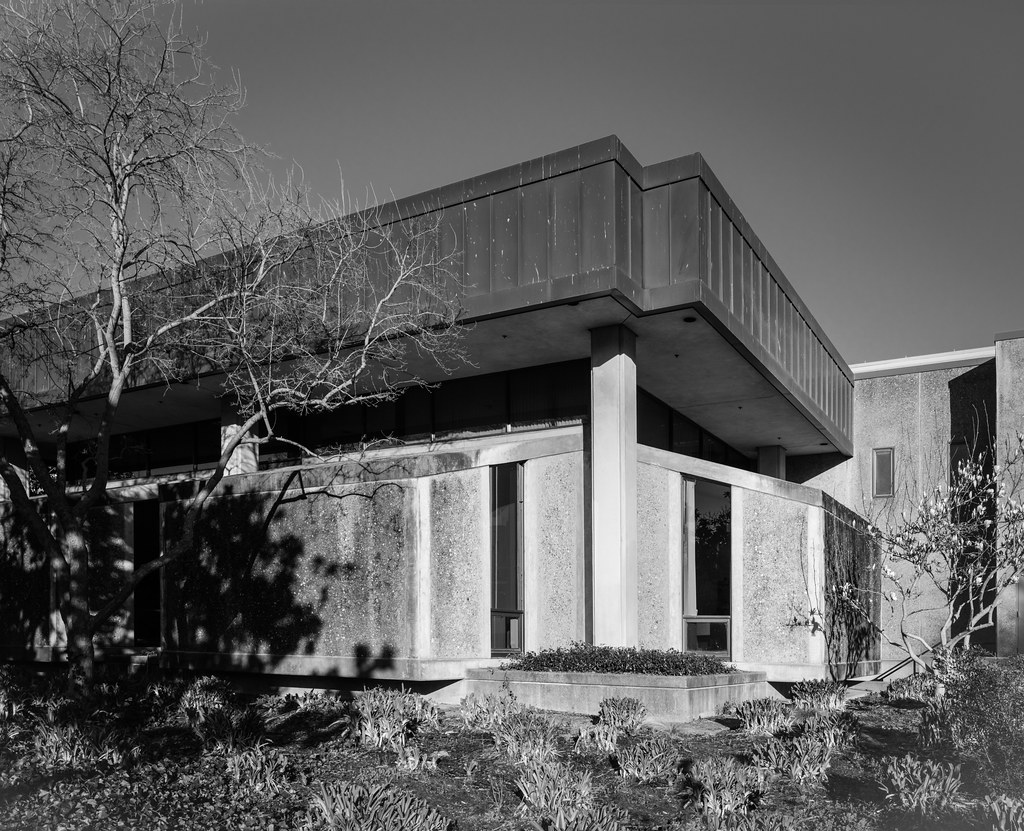 |
| City Hall Annex in Santa Rosa. Photo ©Darren Bradley |
The answer to this mystery became clear when I happened to come across a news report from 1969 about a major earthquake that shook the region that year. Turns out there were two of them, and they caused quite a bit of damage, despite being relatively small.
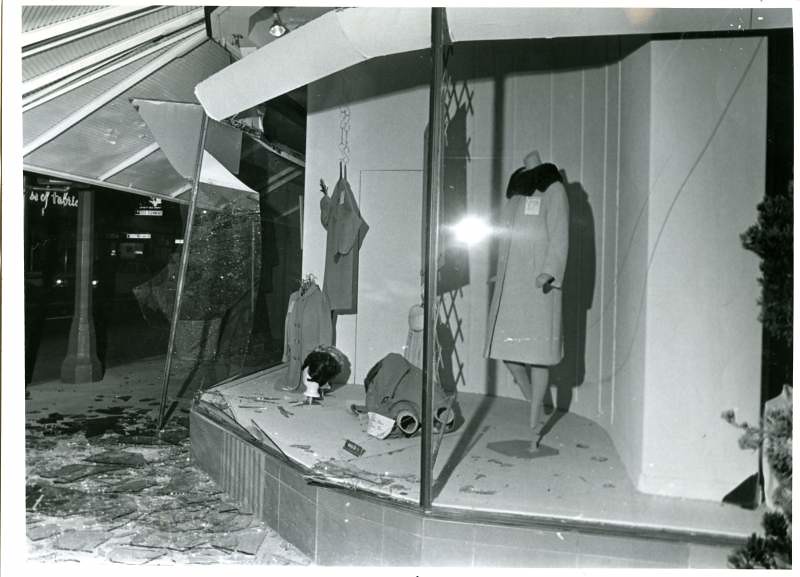 |
| Damage from the Santa Rosa Earthquake of October 1, 1969. Photo from the archives of the Santa Rosa Press-Democrat. |
This meant that much of the city had been redeveloped during the 1970s - during the prime of Late Modern architecture. That makes Santa Rosa unique in that regard, and has created here a haven of beautifully maintained and intact examples of this genre.
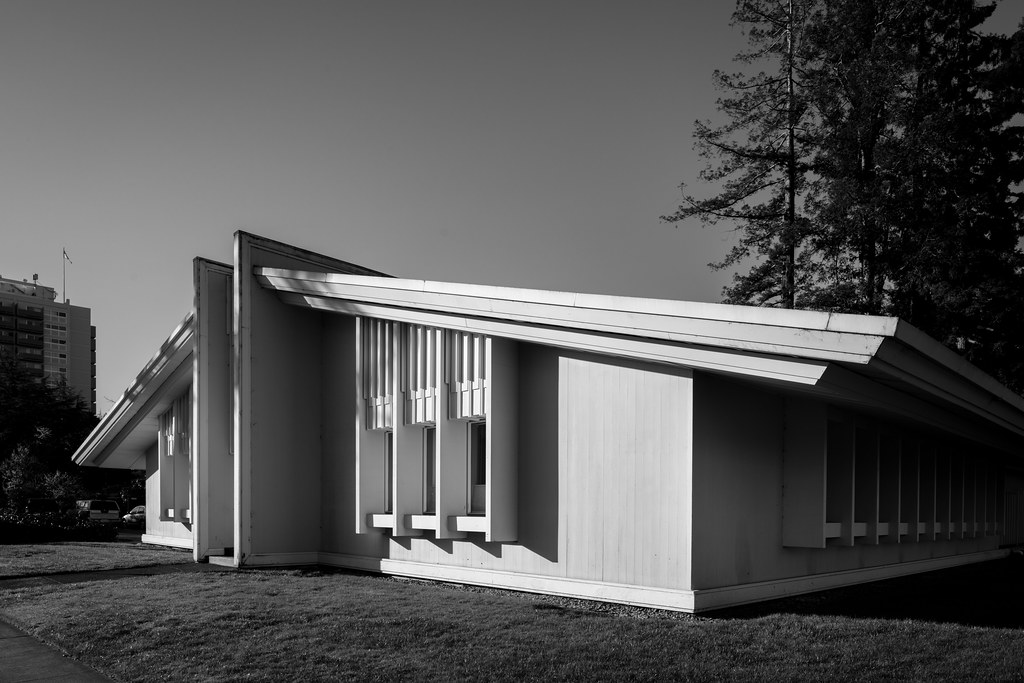 |
| Office building in Santa Rosa. Photo ©Darren Bradley |
It’s the perfect place to re-evaluate pre-conceived notions about Late Modern architecture, and it’s a nice place to explore on foot on a sunny day (before retiring to the Russian River Brewery for a beer or three).
Finally, I’d like to convey a warm thank you to Katherine Rinehart and the staff and commissioners of the Sonoma County Library for the invitation to come up and speak, and for their generous hospitality. . Sheila McCarthy Rutz, the daughter of architect Francis Joseph McCarthy, also attended and stayed after to chat, which was a fantastic and unexpected surprise. And thank you to Copperfield Books for ordering our book and having it available for a book signing. Thank you, Santa Rosa!




















Thanks for sharing these, I never would have expected such a trove of great late-modern buildings up there.
ReplyDeleteInsightful information shared here. One can also get the admission in government colleges of architecture in maharashtra only at SMMCA Nagpur. Thanks for sharing.
ReplyDeleteI always thought the Executive Suites of the old Las Robles on Cleveland where sort of Atomic era.
ReplyDeleteThis comment has been removed by the author.
ReplyDeletenhung mau nha pho hien dai sang trong, thiet ke kien truc don gian nhung rat dep
ReplyDeleteThis comment has been removed by the author.
ReplyDeleteThis comment has been removed by the author.
ReplyDeleteThis comment has been removed by the author.
ReplyDeleteNice content
ReplyDeleteThanks for the shharing
Consulting in India
https://pazhooheshgar.com/
ReplyDeleteGreat article. A lot of the architecture in DT Santa Rosa is brutalist and dehumanizing. That's why the city can't revitalize.
ReplyDeleteGood picture of the library. I was working there when it opened back in the mid-sixties.
ReplyDeleteThis information is really good and helpful.
ReplyDeleteI feel very happy after reading your blog.
It is really helpful for new people.
Thank you for sharing this blog with us.
student one wharf street
Nice Blog.Thank you for sharing the information. Wonderful blog & good post. It's really helpful for me, waiting for a more new post.
ReplyDeletestudent accommodation manchester
Nice Post. Informative post about Architecture Elements. Modern Architects in Chennai.
ReplyDeleteNice blog with Amazing information .. love to read about this.
ReplyDeleteAwaiting your new post
royal attitude status killer attitude status
your content is really great
ReplyDeleteBest Handyman Services
Rug for your home
Chrome Door Numbers
Emergency Electricians
Bedroom Ready for Romance
Affordable Bed Bug Trap
Really crucial information about architecture... Really Nice Job Done...
ReplyDeleteInterior Decorators Chennai
Relax at Home
Exotic Bromelaid Grown
Parametric Architecture
United Furniture
Blackout Curtains for Home
p6k59z0p45 u8s47q7y90 j8m42o1t53 o6p40e8a38 g4e91k0a09 f1p76v2k65
ReplyDeleteI really love this beautiful places. I am very happy to read this blog. Thanks for sharing this blog and good information. Now it's time to avail solar in texas for more information.
ReplyDeleteIn Santa Rosa California, in the community of Oakmont, there is a large building that is a monument to true, Sonoma County, MidCentury Modern architecture. It's called The Berger Center. You need to see it to really understand how unique it is. A building of this design would never be built today due to cost of materials. The buttresses are amazing. It's a ver cool building.
ReplyDeletehttps://goo.gl/maps/ka1jyaJMYMxDWNfLA
The community of Oakmont is looking to level it too. Such a shame.
Good information.
ReplyDelete-----------------------------
I work in stabilitamerica.com
Selfish Fake Relationship Quotes in Tamil
ReplyDeleteExploring \[Late] Modernism in Santa Rosa, California reveals a bold architectural legacy—where concrete, sharp angles, and sculptural forms reflect a time of design experimentation and urban ambition.
ReplyDeleteThis post really speaks to the struggles many students face when working on their dissertations. At one point in my academic journey, I was overwhelmed by the complexity of my research. That’s when I looked into psychology dissertation help, and it made a world of difference. Having expert guidance not only improved the quality of my writing but also gave me the confidence to move forward. It’s great to see resources being shared for students who need support. I highly recommend seeking professional help when you're stuck—it's a smart move, not a shortcut.
ReplyDelete